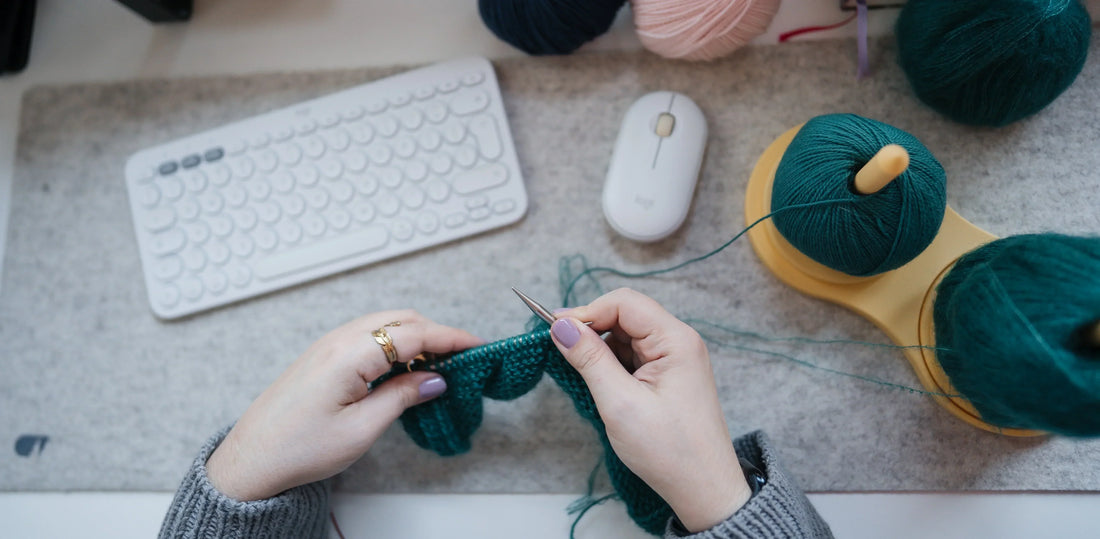
How to Calculate Yarn Requirements for Your Knitting Project
Deel
Calculating yarn requirements can help you avoid running out of yarn mid-project or buying too much. A clear plan saves time, money, and effort.
Every project has specific yarn needs. Pattern instructions, yarn labels, and simple measurements provide all the clues. With basic math, a small swatch, and careful reading, you can plan accurately and confidently.
This guide provides straightforward, reliable methods for calculating yarn for any knitting pattern. Each step is clear, practical, and easy to use, making yarn shopping and project planning much more enjoyable.

Check the Original Pattern Requirements
A knitting pattern usually lists the exact yarn requirements. Most patterns specify the recommended yarn, weight, and total yardage or number of skeins.
When checking the yarn section of the pattern, look for:
- Yarn weight (such as DK, worsted, or fingering)
- Total length of yarn needed (usually in meters or yards)
- Suggested number of skeins
Patterns often include yarn amounts per size. If you’re using the recommended yarn, simply select the numbers that match your project size, and that’s it.
Sometimes patterns list only the number of skeins without the total length. When this happens, check the yardage per skein of the recommended yarn. You can usually find this on the yarn label or by looking it up online.
Accurate yarn planning always begins with fully understanding what the pattern tells you. It’s the foundation for every calculation that follows.

Understanding Yarn Labels
Yarn labels provide essential information: weight, length, recommended needle size, and care instructions.
Look for these key details:
- Weight: Categories like lace, fingering, DK, worsted, and bulky indicate the yarn’s thickness.
- Length per Ball: The number of meters or yards in one skein.
- Fiber Content: Different fibers (like wool, cotton, or silk) behave differently in projects.
- Recommended Needle Size: This helps you match the yarn to the pattern’s gauge.
When substituting yarn, matching both the weight and fiber content is important. Different fibers and thicknesses can significantly change the fabric’s drape, texture, and fit.
Some yarn labels also offer general yardage estimates for common projects, which can be useful when self-drafting patterns or exploring yarn substitutions.
Taking all this into account helps you avoid surprises and keeps your project on track.
Yarn Substitution Basics
Yarn substitution happens when you use a different yarn than the one listed in the pattern. Substituting correctly ensures your final project looks and feels as intended.
Match Yarn Weight
Start by selecting a yarn with the same weight category as recommended in the pattern (lace, fingering, DK, worsted, bulky). This is often indicated on the yarn label.
It’s also helpful to compare the meters or yards per 100 grams. Two yarns in the same weight category can vary in thickness, so yardage is often a more reliable measure than weight alone.
Check Gauge
Gauge is the number of stitches and rows per 10 cm (4 inches). The substitute yarn should match the pattern’s gauge. If it doesn’t, you may be able to adjust the needle size to achieve the correct gauge.
Compare Yardage
Different brands offer different lengths per skein, even within the same weight category. Always compare total yardage, not just the number of skeins.
Adjust Skein Quantities
Use this formula to adjust:
Pattern Yardage ÷ New Yarn Yardage per Ball = Number of Balls Needed
Always round up to the next full skein to be safe.
Choosing the right substitute and calculating carefully ensures the final result matches your vision.

The Simple Math Method: Step-by-Step Yarn Calculation
Yarn amounts can be calculated quickly using basic math.
Step 1: Find the Total Yarn Requirement
Check the pattern for the total yarn length in meters or yards.
Example: 800 meters
Step 2: Find the Length per Ball
Check the yarn label for the length per ball.
Example: 120 meters per ball
Step 3: Divide the Total by the Yarn Length
Total Pattern Yarn ÷ Length per Ball = Number of Balls Needed
Example: 800 ÷ 120 = 6.67 balls → Round up to 7 balls
Quick Tip: Always compare lengths, not just the number of skeins.
Swatching to Measure Yarn Consumption
Swatching is the most accurate way to calculate yarn requirements. A small, measured sample shows exactly how much yarn your project will use with your chosen yarn, needles, and knitting style. Of course, you can’t make a swatch without buying yarn for the project, but if you're shopping from your stash, a swatch may help to check if you have enough yarn for the project.
Step 1: Knit a Swatch
Make a square at least 10 x 10 cm using the yarn and needles you plan to use.
Step 2: Measure the Yarn Used
Unravel the swatch and measure how much yarn you used.
Example: 8 meters for a 10 x 10 cm swatch.
Step 3: Calculate Yarn Usage per Square Centimeter
Swatch area: 10 cm x 10 cm = 100 cm²
Example: Yarn per cm²: 8 meters ÷ 100 cm² = 0.08 meters per cm²
Step 4: Measure Project Area
Example: A scarf measuring 20 cm x 150 cm = 3,000 cm²
Step 5: Calculate Total Yarn Needed
0.08 meters per cm² x 3,000 cm² = 240 meters needed
Step 6: Convert to Skeins
240 meters ÷ 120 meters per ball = 2 balls → Round up to 3 balls
Swatching is especially useful for custom designs and stitch patterns that use unusual amounts of yarn.

Adjusting for Modifications
Changing a pattern’s size or design affects yarn requirements. A longer sweater, wider scarf, or added cables will need more yarn.
Adjust for Length
Adding length to sleeves, sweater bodies, or scarves increases the surface area. A good rule of thumb is to estimate an additional 10% of yarn per 10 cm.
Adjust for Width
Widening a garment increases the number of stitches per row and requires more yarn.
Example: Increasing by one size, add 5–10% more yarn.
Adjust for Different Stitch Patterns
- Lace patterns typically use less yarn.
- Cables, ribbing, and textured stitches use more yarn.
Plan for 10% to 20% extra yarn when adding dense stitch patterns.
Modifications add personality to your project. Careful yarn planning keeps those changes stress-free.
Quick Reference Chart: Average Yarn Requirements
This chart offers general yarn estimates for common projects. These numbers provide a useful starting point when planning or comparing yarns.
| Project Type | Yarn Weight | Approximate Yarn Needed |
|---|---|---|
| Adult Hat | DK / Worsted | 100 – 150 meters |
| Scarf (Standard Size) | DK / Worsted | 300 – 500 meters |
| Pair of Socks | Fingering | 350 – 400 meters |
| Baby Sweater | DK | 250 – 350 meters |
| Adult Sweater (Size M) | DK / Worsted | 1,000 – 1,400 meters |
| Shawl (Medium) | Fingering | 400 – 600 meters |
Notes:
- Add extra yarn for longer sleeves, added texture, or size adjustments.
- When in doubt, buy one extra skein to stay safe.
- These are general guidelines—always check your pattern and swatch for more accuracy.
Final Thoughts
Calculating yarn requirements is a skill that makes every project easier to plan. Quick estimates, label checks, swatching, and smart substitutions all lead to better results and fewer surprises. A little preparation saves time, money, and effort.
Start your next project with confidence. Browse our yarn collection, explore new patterns, and put these simple methods to work.

